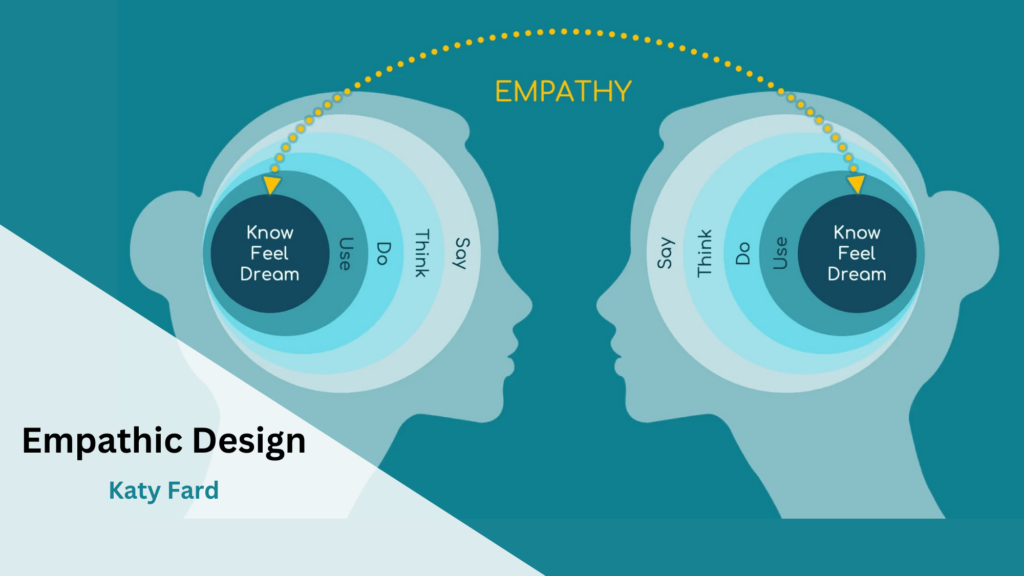In today’s hyper-connected world, the success of a product or service largely depends on its ability to establish and maintain meaningful connections with users. Empathic design, a human-centered approach that emphasizes understanding the needs, emotions, and experiences of users, has emerged as a powerful tool for creating these connections. By deeply engaging with users’ perspectives, feelings, and challenges, empathic design enables designers to develop solutions that resonate on a personal level. This essay explores how empathic design can foster meaningful connections with users and drive product success.
Understanding Empathic Design
Empathic design, also known as empathetic design or empathy-driven design, is a design methodology rooted in the concept of empathy – the ability to understand and share the feelings of others. This approach requires designers to immerse themselves in the world of their users, going beyond demographic data and surface-level preferences to uncover deeper insights. By conducting ethnographic research, engaging in active listening, and embracing diverse viewpoints, designers can gain a holistic understanding of users’ lives, motivations, and pain points.
Empathic design goes beyond traditional user-centered design by placing a strong emphasis on emotional resonance. It acknowledges that users are complex individuals with unique experiences, values, and aspirations. By adopting a mindset of compassion and empathy, designers can develop a profound appreciation for the diverse needs and preferences of their audience.
Creating User-Centric Solutions
One of the key benefits of empathic design is its ability to inspire the creation of user-centric solutions. By empathizing with users, designers can uncover unmet needs and opportunities for improvement. Through methods such as in-depth interviews, observational studies, and participatory design sessions, designers can gain valuable insights into the everyday experiences and challenges faced by their target audience.
Armed with this knowledge, designers can craft products and services that address real-life pain points and aspirations. Whether it’s designing a mobile app that simplifies the grocery shopping experience for busy parents or creating a wellness program that resonates with individuals struggling with mental health issues, empathic design enables the development of solutions that truly matter to users. By aligning with users’ emotional and functional needs, these solutions have the potential to forge lasting connections and catalyze positive change in users’ lives.
Fostering Emotional Engagement
Emotional engagement lies at the heart of meaningful connections between users and products or services. Empathic design excels in fostering emotional engagement by acknowledging and responding to users’ feelings and motivations. By recognizing the emotional landscape of their users, designers can infuse their creations with empathy, authenticity, and a human touch.
This emotional resonance is evident in products and experiences that evoke joy, comfort, confidence, or a sense of belonging. Whether it’s a digital platform that celebrates inclusivity and diversity or a physical product that triggers feelings of nostalgia and warmth, empathic design has the power to create emotional bonds that transcend mere functionality.
Empathic design also plays a pivotal role in cultivating trust and loyalty among users. When users feel understood, respected, and valued by the products and brands they interact with, they are more likely to develop strong emotional attachments. These attachments can lead to enduring relationships, repeat engagements, and positive word-of-mouth recommendations, contributing to the long-term success of a product or service.
Enabling Inclusive Experiences
Inclusivity and diversity are integral aspects of empathic design. By embracing a wide range of perspectives, needs, and abilities, designers can create inclusive experiences that resonate with diverse user groups. This approach acknowledges that users span a spectrum of identities, backgrounds, and abilities, and aims to ensure that no one is left behind.
Empathic design encourages designers to consider the needs of marginalized or underrepresented communities and to actively seek out their input. By designing with empathy for inclusivity, designers can create experiences that empower, uplift, and validate individuals who have historically been overlooked or underserved. This commitment to inclusivity not only expands the reach of a product or service but also demonstrates a genuine commitment to social responsibility and ethical design practices.
Driving Business Success
Beyond its humanistic value, empathic design can also be a powerful driver of business success. By forging meaningful connections with users, products and services can differentiate themselves in crowded markets and build a loyal customer base. Empathic design enables organizations to deliver experiences that stand out for their emotional resonance and relevance, driving customer satisfaction and loyalty.
Moreover, empathic design can lead to innovations that address unmet needs and create new opportunities for growth. By deeply understanding users’ experiences and aspirations, organizations can identify market gaps and shape offerings that are truly distinctive. This approach fosters a culture of continuous improvement, helping organizations stay attuned to the evolving needs and expectations of their user base.
Conclusion
Empathic design stands as a potent force in creating meaningful connections with users. By centering on empathy and human understanding, designers can craft solutions that resonate on a deeply emotional level, foster trust, and empower individuals from all walks of life. As technology continues to reshape the ways we interact with the world, empathic design offers a pathway to bridge the gap between human needs and the offerings of the digital age. By embracing empathic design, organizations can embody a spirit of compassion, inclusivity, and innovation, elevating the human experience in a meaningful and lasting manner.


How can empathic design influence consumer behavior and purchasing decisions
Hello Simba,
In my opinion, empathic design involves understanding and addressing the needs and emotions of users, leading to products that resonate with them on a deeper level. By acknowledging and empathizing with consumers’ experiences, empathic design can generate stronger emotional connections between users and products, ultimately influencing purchasing decisions. When consumers feel that a product was designed with their well-being and emotions in mind, they are more likely to develop a sense of loyalty and connection to the brand.
How interesting this theme of empathic design was. I never thought that it could be so effective.
I am glad that it was helpful, Fatima.
Could you give some examples of empathic designs?
Hello Shomie,
Sure! Examples of empathic design include medical devices that prioritize patient comfort and ease of use, smartphones with features tailored to individuals with varying abilities, public spaces designed to accommodate diverse needs, and ergonomic furniture that prioritizes user comfort and well-being. These designs prioritize understanding and addressing the needs, emotions, and experiences of the people who will be using them. They aim to create inclusive, supportive, and effective solutions that cater to the unique perspectives and requirements of the users. From user-friendly products to accessible public spaces, empathic design seeks to foster a deeper understanding of the human experience and ensure that the designed solutions are sensitive to the diverse needs, emotions, and experiences of the individuals they serve.
In terms of color, how can we choose the right colors to use in website design?
Hello Rose,
The choice of color depends on various factors. For instance, branding, target audience, contrast, readability, color harmony, etc.
Hello Katy Fard,
How does empathy play a crucial role in the design process, particularly when considering inclusivity and diversity?
Empathy is crucial in the design process, especially when considering inclusivity and diversity, as it helps designers understand the diverse needs and experiences of users. By empathizing with different user groups, designers can create products and experiences that resonate with a variety of identities and abilities, ensuring that everyone is considered. This empathic approach leads to more inclusive and user-centric designs, as it fosters a deeper understanding of users’ needs and challenges. Incorporating empathy into the design process helps designers connect with diverse user groups and ensures that products and experiences are truly inclusive and reflective of the varied needs of the intended audience.
I loved as much as you’ll receive carried out right here. The sketch is attractive, your authored material stylish.
Many thanks dear!